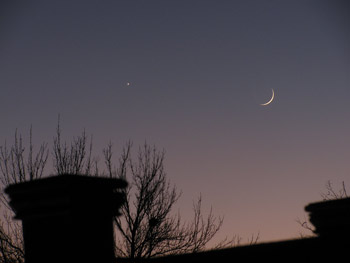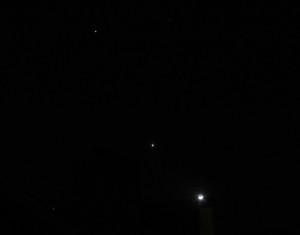Create a free profile to get unlimited access to exclusive videos, sweepstakes, and more!
See Venus in broad daylight today!

Venus is the third brightest natural object in the sky after the Sun and the Moon -- and today is one of your best chances all year to see Venus in broad daylight.
 I took this pic of the two together last November.
I took this pic of the two together last November.Venus is so bright it can be seen even during the day when the Sun is up. I've seen it many times before even at noon -- but it ain't easy. The problem is that the sky is big and bright, and Venus is small, just a dot, and can be very difficult to find initially. And even after you find it in the sky it's really easy to lose it among all that blue. But today we have a cheat -- the Moon! As the Moon orbits the Earth, it changes its position in the sky. Today, pretty much all day, it's very close to the position of Venus. Of course, they aren't physically close together -- the Moon is about 380,000 km away, while Venus is 141 million km distant -- but they happen to line up as seen from Earth. And while the Moon is a thin crescent, it's not too hard to find.
[These instructions are for folks in the northern hemisphere. If you live below the Equator, flip left for right and up for down.]
If you want to try, go outside and face the Sun (don't look right at it: despite "common wisdom" it's pretty hard to do serious damage to your eyes by looking at the Sun especially if you just glance at it, but it hardly is good for you, and the glare will make it harder to see anything at all). [UPDATED TO ADD: by this last bit, I mean that you can do permanent minor damage by staring at the Sun -- commonly black spots where the retina gets damaged -- or major temporary damage -- like not being able to see for a while, but which can subside -- but it's hard to go permanently and totally blind. But as I pointed out, it's not a good idea under any circumstances.] Hold your left arm straight out from your body -- that represents the angle 90° from the Sun in the sky. The Moon is just about halfway between the Sun and where your left arm is pointing - about 40° from the Sun. This method is rough and you'll have to scan around to find the crescent Moon, but be patient and persistent. It'll pay off. It might help to have some trees or buildings a distance away from you as landmarks to help you keep the Moon spotted once you find it.
Once you find it, look just below it, about the width of one finger held out at arm's length. Venus should be there. Again, be patient; this isn't easy. Also, it may help if you use binoculars, but be very careful not to point them near the Sun! That's a recipe for boiled retinae.
If you find it, yay! You might even try to go for Jupiter, which is much more challenging. Jupiter is about 15° farther east from the Moon/Venus pair (that is, farther away from the Sun). Mentally connect a line between the Sun and the Moon, then continue it about half that distance more to the left. You'll almost certainly need binoculars, since Jupiter is less than a quarter as bright as Venus, making it that much harder to spot.
 And don't fret if you can't find them! There's an even easier trick: wait a few hours. Once the Sun gets close to setting and the sky is darker, Venus is a lot easier to find. Just face west after sunset, and boom! You won't miss it. The Moon will be very close, and the two will make an incredible pair in the sky, with Jupiter lurking above them. In fact, if you go out right after sunset, you might spot elusive Mercury just above the horizon as well! The picture here shows the scene from last night; I took it myself from my back yard [click to embiggen]. You can see the thin crescent Moon (the dark side lit by reflected Earth light), Venus above it, and Jupiter above that. Tonight, the Moon will slide just past Venus on the right. It'll be a fantastic photo opportunity, so if you have a simple point-and-shoot camera and a tripod, give it a shot! That's all I used to get that picture.
And don't fret if you can't find them! There's an even easier trick: wait a few hours. Once the Sun gets close to setting and the sky is darker, Venus is a lot easier to find. Just face west after sunset, and boom! You won't miss it. The Moon will be very close, and the two will make an incredible pair in the sky, with Jupiter lurking above them. In fact, if you go out right after sunset, you might spot elusive Mercury just above the horizon as well! The picture here shows the scene from last night; I took it myself from my back yard [click to embiggen]. You can see the thin crescent Moon (the dark side lit by reflected Earth light), Venus above it, and Jupiter above that. Tonight, the Moon will slide just past Venus on the right. It'll be a fantastic photo opportunity, so if you have a simple point-and-shoot camera and a tripod, give it a shot! That's all I used to get that picture.
And if it's cloudy where you are, or you just simply miss this chance, you'll get another one in a month: on March 26th the Moon will once again be pretty close to Venus. Due to the dance of the planets, Jupiter will be between Venus and the Sun by then too, and quite a bit closer to Venus. That might make it easier to see during the day as well.
Related posts:
- Venus and the Moon, looking pretty
- The Moon and Venus, a gorgeous pair
- See Venus during the day!
- The Moon and Venus, sittinâ in a tree


























